Research - (2022) Volume 10, Issue 2
Comparing the Antifungal Efficacy of Three Endodontic Sealers (AH Plus, Seal apex, and MTA Fill Apex) with and without the Incorporation of Origanum vulgare Oil against Candida albicans: An In-Vitro Study
Rohit Amburle*, Rishikesh Meshram, Nikhil Sathawane and Snehal Gaware
*Correspondence: Rohit Amburle, Department of Conservative Dentistry and Endodontics, Swargiya Dadasaheb Kalmegh Smruti Dental College and Hospital, Nagpur, Maharashtra, India, Email:
Abstract
Aim: The aim of this study was to compare the antifungal efficacy of three endodontic sealers (AH Plus, Sealapex, and MTA Fillapex) with and without the incorporation of Origanum vulgare oil against Candida albicans. Materials and Methods: In the present study C. albicans were cultured in Potato Dextrose Agar plates. Filter papers (n=10) were placed in the cultured Petri dishes and the sealers were mixed according to the manufacturer's instructions and placed on the top of the filter papers. Sealers were divided into following groups: Group I–AH Plus, Group II–Sealapex, and Group III–MTA Fillapex. Group IO, Group IIO, and Group IIIO were the addition of 25 µg/ml of Origanum vulgare oil with respective sealers. Plates were incubated for 18 h, and the zone of inhibition was measured with a measuring scale and values (in millimetre) were recorded. Statistical analysis: Statistical analysis was done by one-way analysis of variance followed by post hoc multiple pair-wise comparisons. Results: All the tested groups showed statistically significant difference (p<0.05) from each other. Essential oil of Origanum vulgare showed superior zone of inhibition compared to sealers used alone. Group IC (16.35 ± 0.71 mm) had the highest zone of inhibition followed by Group I (13.8 ± 0.86 mm). For the remaining groups, the zone of inhibition was in the following order: Group IIO>Group II>Group IIIO>Group III. Conclusion: AH Plus sealer mixed with Origanum oil showed significantly higher antifungal property. Mixing of Origanum oil with endodontic sealer provides an added advantage so that endodontic re infections can be minimized and will be helpful in retreatment cases.
Keywords
C. albicans, Origanum vulgare, Periapical diseases, Endodontic sealer
Introduction
Microorganisms are the primary cause for occurrence of pulpal/periapical diseases [1]. To achieve successful endodontic treatment, it is important to prevent and treat the per radicular inflammation by eliminating the microorganisms from the root canal systems [2]. Root canal system is a closed space or chamber with low oxygen concentration and serves as an incubator promoting the growth of microorganisms [3]. The microbial environment of an infected root canal is a habitat for various bacteria, spirochetes and fungi [4]. Reminance of these microorganisms after primary root canal treatment may lead to treatment failure. It has also been seen that fungus plays a significant role in the development of various endodontic diseases, Candida albicans being the most common fungal species detected in oral environment [1].
Endodontic sealers are used to create a fluid-tight barrier between core filling material and root canal walls, and their antibacterial effects help to eliminate bacteria that remain in the root canals following cleaning and shaping processes [5]. An ideal endodontic sealer should be tissue compatible, provide an airtight seal and have sufficient antimicrobial properties. A good antimicrobial root canal sealer may be able to cope better with a prolonged residual infection and micro-organisms re-entering through the oral cavity, enhancing the possibility of a successful endodontic treatment results [6].
One of the most important factors which helps in healing of the periapical tissues is root canal sterilization. In spite of rigorous cleaning, shaping and use of intracanal medicaments, it is not possible to completely eliminate all the micro-organisms from the root canal system, which may result in failure of endodontic treatment. The major etiological cause for pulp necrosis and apical periodontitis are the micro-organisms and their byproducts [7].
The success of obturation depends upon the ability to remove the microorganisms with the help of mechanical cleaning and shaping, along with the use of microbial irrigants, sufficient filling of the empty space, and the application of antimicrobial dressings in between the appointments, if required. Therefore, antimicrobial agents are incorporated to root canal sealers to enhance their efficacy [8].
Antimicrobial and antioxidant properties have long been known to exist in essential oils derived from aromatic and therapeutic plants. Orieganum vulgare (Lamiaceae family) is an indigenous plant found in India, Iran's Southern provinces, and the Mediterranean region that has traditionally been used as an antiseptic. Origanum essential oil is edible plant oil that can be used in food products. It has received approval from the Food and Drug Administration, Code of federal regulations, Title 21 part 582, in the year 2004 [9].
Root canal sealers can be classified according to the chemical composition as zinc oxide-eugenol-based, calcium hydroxide-containing, glass ionomer-based, epoxy resin-based, and mineral trioxide aggregate (MTA)-based sealers. Due to the difference in composition of the available sealers and taking into account the American National Standards Institute/ American Dental Association standards, the aim of this study was to compare the antifungal efficacy of three endodontic sealers (AH Plus, Sealapex, and MTA Fillapex) with and without the incorporation of Origanum vulgare oil against Candida albicans.
Materials and Method
The study was carried out using three endodontic sealers namely Resin based Sealer - AH Plus (Figure 1), Calcium Hydroxide based sealer - Sealapex (Figure 2), and MTA based sealer - MTA Fillapex (Figure 3) with and without the incorporation of Origanum vulgare oil (Figure 4) against Candida albicans.
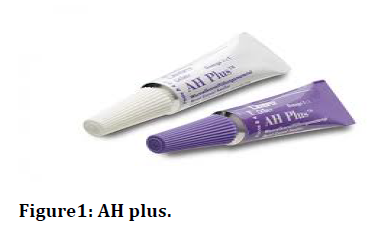
Figure 1. AH plus
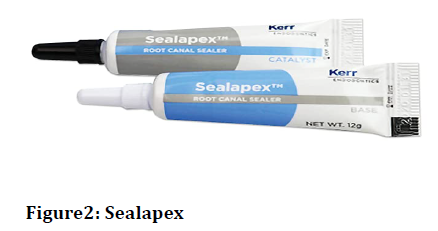
Figure 2. Sealapex
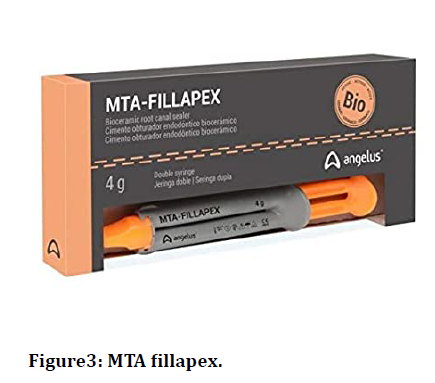
Figure 3. MTA fillapex
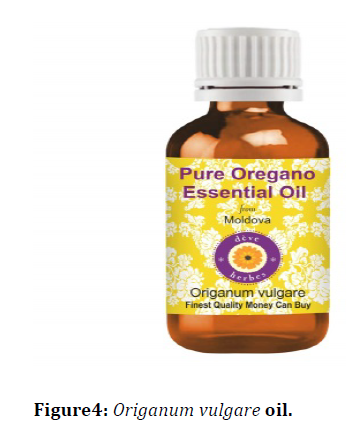
Figure 4. Origanum vulgare oil
Group division of sealers is as follows:
• Group I–AH plus (Figure 5).
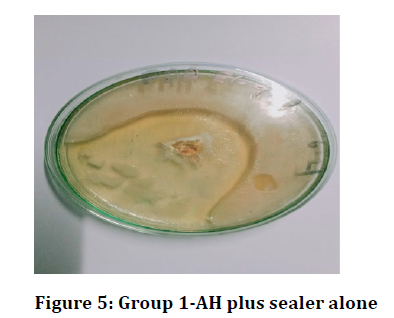
Figure 5. Group 1-AH plus sealer alone
• Group II–Sealapex (Figure 6).
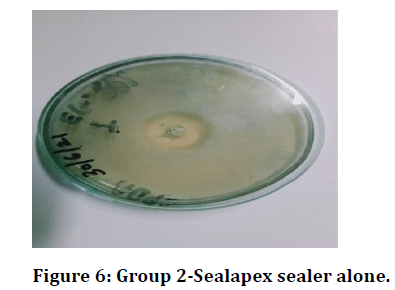
Figure 6. Group 2-Sealapex sealer alone
• Group III–MTA Fillapex (Figure 7).
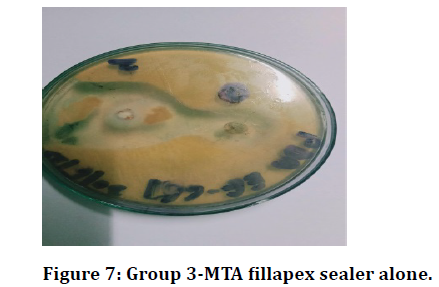
Figure 7. Group 3-MTA fillapex sealer alone
• Group IO, Group IIO, and Group IIIO were the addition of 25 μg/ml of Origanum vulgare oil with respective sealers (Figures 8-10).
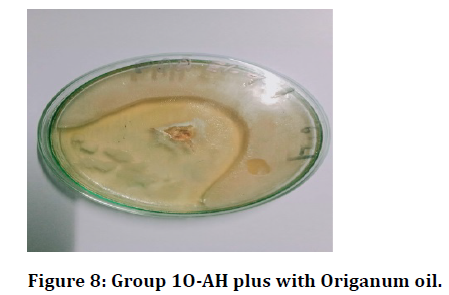
Figure 8. Group 1O-AH plus with Origanum oil
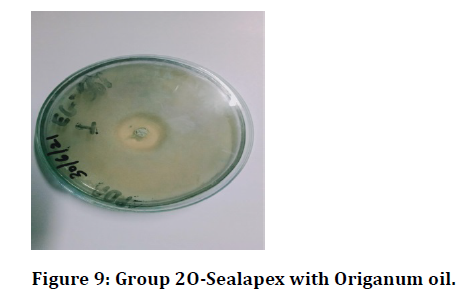
Figure 9. Group 2O-Sealapex with Origanum oil
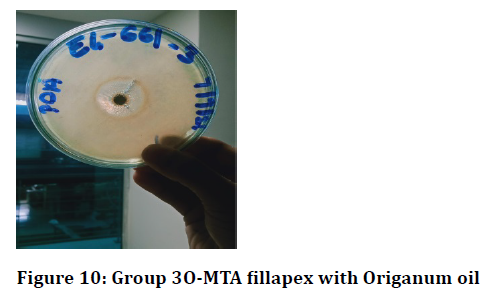
Figure 10. Group 3O-MTA fillapex with Origanum oil
Strains of Candida albicans (ATCC 10231) were collected and cultured with Potato Dextrose agar (PDA) plates. Brain heart infusion (BHI) was the broth used in the study. C. albicans (0.5 ml broth) was inoculated in BHI broth and incubated for 4hrs. 0.1 ml of incubated broth was spread on PDA plate. Wells of 0.5 mm diameter and 0.5 mm depth were made. Filter papers (n=10) were placed in the cultured Petri dishes. The sealers were then mixed according to the manufacturer's instructions (0.1 gm) and mixed with Origanum oil at 25μgm/ml concentration and introduced into the well. Agar Plates were incubated at 25 degrees for 5 days, and the zone of inhibition was measured with a measuring scale and values (in millimetre) were recorded.
Statistical Analysis
Statistical analysis was done by one-way analysis of variance followed by post hoc multiple pair-wise comparisons.
Statistical analysis was done by using descriptive and inferential statistics using Student’s paired t test, one way ANOVA and Mann Whitney U test. Software used in the analysis was SPSS 27.0 version and Graph Pad Prism 6.0 version. p<0.05 is considered as level of significance.
Results
All the tested groups showed statistically significant difference (P<0.05) from each other. Essential oil of Origanum vulgare showed superior zone of inhibition compared to sealers used alone. Group IO (16.35 ± 0.71 mm) had the highest zone of inhibition followed by Group I (13.8 ± 0.86 mm). For the remaining groups, the zone of inhibition was in the following order: Group IIO>Group II>Group IIIO>Group III. Comparison of mean size (Zone of inhibition) among groups with control is given in Table 1.
| Groups (n=5) | Mean ± SD (mm) | SE mean | P |
| Group I | 35.8 ± 1.92 | 0.86 | 0 |
| Group II | 14.8 ± 1.92 | 0.86 | 0.02 |
| Group III | 24.8 ± 2.58 | 1.15 | 0.05 |
| Group 1O | 44.8 ± 3.11 | 1.39 | 0 |
| Group IIO | 18 ± 1.58 | 0.7 | 0.02 |
| Group IIIO |  28 ± 2 | 0.89 | 0.05 |
Table1. Comparison of mean size (Zone of inhibition) among groups with control
Discussion
The presence of bacteria in the root canal system frequently causes root canal therapy to fail, resulting in pulpal and periapical infections [10]. The success of endodontic treatment depends upon instrumentation and disinfection of the root canal system, and the close fit of the restorative material to the canal space, promoting a good seal and limiting the bacterial leakage [11].
The most prevalent bacteria in the endodontic microbiota are facultative and strict anaerobic bacteria, which produce infections that induce periapical bone resorption and are resistant to endodontic treatment. Facultative microorganisms including E. faecalis, S. aureus, and even Candida albicans have been identified as the most resistant oral species and potential source of root canal treatment failures [12].
The presence of Candida albicans in the root canals has been linked to periapical pathosis that is resistant to treatment [13]. The most common fungal species that is identified in infected root canals are C.albicans. It is a dentinophilic microbe due to its invasive affinity for dentin [14].
Hence, C.albicans was selected as the test organism in our study. One of the most commonly used procedures for testing the antibacterial activity of dental materials is the agar diffusion test, which was employed in this study. The advantages of this approach include the ability to make direct comparisons between root canal sealers and test microorganisms, as well as a visible indication of which sealer has the capability to remove microorganisms in the local microenvironment of the root canal system [15].
It also assesses the impact of direct and close contact between the test microorganism and the material under investigation on microbial viability, irrespective of the diffusibility and solubility of the antimicrobial components [13]. Therefore, this test was considered a standard to evaluate the antimicrobial activity of the tested samples.
In the same way as reported by Kopper et al.,[16] there was no need of using a positive control group in the present study because microbial viability was assessed on dishes in which microbial growth was observed. Furthermore, the evaluated materials passed a sterility test, indicating that they were not contaminated, which may have tampered with the study's findings.
A root canal sealer with antimicrobial activity may be able to cope better with a prolonged residual infection and coronal microbial leakage, enhancing the likelihood of a favorable endodontic treatment result [17]. There are a variety of root canal sealers available, each with its own formula and chemical composition. The sealers utilized in the present study were Resin based Sealer - AH Plus, Calcium Hydroxide based sealer - Sealapex, and MTA based sealer - MTA Fillapex.
MTA-based sealers (MTA Fillapex, Angelus, Brazil) are noted for their outstanding biocompatibility, ability to stimulate mineralization, and improved push-out strength over zinc oxide eugenol cements. MTA is made up of calcium oxide, which works in a similar way to calcium hydroxide. Antimicrobial, physical, and chemical properties of epoxy resin-based sealers (AH Plus) are excellent.
As a result, these sealers reduce microbe survival during obturation [18]. Sealapex (Sybron-Kerr, Romulus, MI, USA) is a calcium hydroxide-based sealer with a greater concentration of Ca2+, which has been linked to periapical tissue healing [7].
One of the desirable qualities of an excellent sealer is antibacterial activity [19]. Antimicrobial components in root canal sealers may become critical in limiting the regrowth of residual micro-organisms and controlling bacterial re-entry into the root canal system. Since antimicrobial components do not have a specific toxicity against microbes, they may also be harmful to host cells, hence biocompatibility is a critical consideration when choosing a sealer for obturation [17].
In this study, 25 μg/ml of Origanum vulgare oil were added with respective sealers. The major constituent of the oregano essential oil is carvacrol (41%). Carvacrol, an oxygenated monoterpene, inhibits ATPase activity and increases no selective permeability of the bacterial cell membrane. It prevents microbial colonisation and renders microorganisms more susceptible to antibacterial medicines. Carvacrol is known to possess strong antioxidant properties and also exhibit antibacterial activity against several bacteria [9].
The results of this study showed statistically significant difference between all the sealers tested (p<0.05). The antifungal activity of the AH Plus sealer was the greatest of all the sealers tested.
The antifungal activity of AH Plus sealer is attributed to the bisphenol-A-diglycidylether component, which also has antibacterial properties. According to Leonardo et al., bisphenol-A-diglycidylether produces formaldehyde during polymerization [20]. The antifungal activity of sealer along with Origanum vulgare oil was higher than that of sealers alone. This shows that Origanum vulgare oil has greater antifungal property and the sealer property is not altered by its addition.
According to the study conducted by Kuga et al., MTA Fillapex exhibited decreased antibacterial efficacy when compared to Sealapex due to lower pH, which could be attributable to variations in the proportion of extractable calcium hydroxide [21].
The size of the inhibition zones depends mainly on two factors which include: (1) Toxicity of the material to a particular strain of bacteria and (2) The ability of the material to diffuse through the particular medium. In turn, three elements influence diffusibility: (1) the substance's hydrophobicity or hydrophobicity, (2) the rate of release from the matrix in which the material is embedded, and (3) the size of the material. These factors are difficult to control in in vitro studies. The test results may vary according to the above-mentioned factors [22].
In endodontic therapy, root canal sealers should be selected which are characterized by adequate antimicrobial activity, good saleability, and an acceptable biocompatibility. However, the results given here were obtained in vitro and in vivo factors such as the existence of dentin and root canal complexity could alter the antibacterial efficiency of sealers. As a result, more in vivo research is needed to assess antimicrobial activity of the sealers.
Conclusion
Under the constraints of this study, root canal sealers infused with Origanum oil showed higher antifungal activity than the sealer used alone. When compared to Sealapex and MTA Fillapex, the antifungal properties of AH Plus sealer coupled with Origanum oil were much higher. Mixing of Origanum oil along with endodontic sealer provides an added advantage so that postendodontic infections can be minimized.
References
- Kangarlou A, Sofiabadi S, Yadegari Z, et al. Antifungal effect of calcium enriched mixture cement against Candida albicans. Â Iran Endod J 2009;4:101.
- Gomes BP, Pedroso JA, Jacinto RC, et al. In vitro evaluation of the antimicrobial activity of five root canal sealers. Braz Dent J 2004;15:30-5.
- Ashraf H, Samiee M, Eslami G, et al. Presence of Candida albicans in root canal system of teeth requiring endodontic retreatment with and without periapical lesions. Iran Endod J 2007;2:24.
- Baumgartner JC, Watts CM, Xia T. Occurrence of Candida albicans in infections of endodontic origin. J Endod 2000; 26:695-8.
- Bouillaguet S, Wataha JC, Tay FR, et al. Initial in vitro biological response to contemporary endodontic sealers. J Endod 2006; 32:989-92.
- Gopikrishna AV, Kandaswamy D, Jeyaval Rajan K. Comparative evaluation of the antimicrobial efficacy of five endodontic root canal sealers against Enterococcus faecalis and Candida albicans. J Cons Dent 2006; 9: 2-11.
- Arora R, Rawat P, Bhayya DP. A comparative evaluation of antimicrobial efficacy of three endodontic sealers: Endoflas FS, AH Plus and sealapex against Enterococcus faecalis-an in vitro study. J Dent Med Sci 2014;13:90-3.
- Sundqvist G, Figdor D, Persson S, et al. Microbiologic analysis of teeth with failed endodontic treatment and the outcome of conservative re-treatment. Oral Surg Oral Med Oral Pathol Oral Radiol Endod 1998 ;85:86-93.
- Krishnamachari Janani PA, Sandhya R, Teja KV. Chemical constituent, minimal inhibitory concentration, and antimicrobial efficiency of essential oil from Origanum vulgare against Enterococcus faecalis: An in vitro study. J Conserv Dent 2019; 22:538.
- Sipert CR, Hussne RP, Nishiyama CK, et al. In vitro antimicrobial activity of fill canal, sealapex, mineral trioxide aggregate, Portland cement and endorez. Int Endod J 2005; 38:539-43.
- Lai CC, Huang FM, Yang HW, et al. Antimicrobial activity of four root canal sealers against endodontic pathogens. Clin Oral Investig 2001; 5:236-9.
- Cavalcanti AL, Limeira FI, Sales EA, et al. In vitro antimicrobial activity of root canal sealers and calcium hydroxide paste. Contemp Clin Dent 2010; 1:164.
- Pattanaik S, Jena A, Shashirekha G. In vitro comparative evaluation of antifungal efficacy of three endodontic sealers with and without incorporation of chitosan nanoparticles against Candida albicans. J Conserv Dent 2019; 22:564.
- Waltimo TM, Haapasalo M, Zehnder M, et al. Clinical aspects related to endodontic yeast infections. Endod Topics 2004; 9:66-78.
- Bhargava R, Shashikala K, Bhargava R. Antibacterial efficacy of three root canal sealers against Enterococcus faecalis and Candida albicans: An in vitro study. SRM J Res Dent Sci 2015; 6:170.
- Kopper PM, de Oliveira Rosa R, de Figueiredo JA, et al. In vitro analysis of antimicrobial activity of theree endodontic sealers. Rev Odonto Cienc 2007; 22:106-11.
- Smadi L, Mahafzah A, Khraisat A. An in vitro evaluation of the antimicrobial activity of nine root canal sealers. J Contemp Dent Pract 2008; 9:60-7.
- Chakraborty T, Taneja S, Malik S. An antimicrobial activity assessment of three endodontic sealers on Enterococcus faecalis, Candida albicans, and Staphylococcus aureus by a direct contact test: An In vitro study. Int J Sci Study 2020; 8:35-39.
- Shantiaee Y, Dianat O, Janani A, et al. In vitro evaluation of the antibacterial activity of three root canal sealers. Iran Endod J 2010; 5:1.
- Leonardo MR, Da Silva LA, Tanomaru Filho M, et al. In vitro evaluation of antimicrobial activity of sealers and pastes used in endodontics. J Endod 2000; 26:391-394.
- Kuga MC, Faria G, Weckwerth PH, et al. Evaluation of the pH, calcium release and antibacterial activity of MTA Fillapex. Rev Odontol UNESP 2013; 42:330-335.
- Al-Khatib ZZ, Baum RH, Morse DR, et al. The antimicrobial effect of various endodontic sealers. Oral Surg Oral Med Oral Pathol 1990; 70:784-90.
Indexed at, Google Scholar, Cross Ref,
Indexed at, Google Scholar, Cross Ref,
Indexed at, Google Scholar, Cross Ref,
Indexed at, Google Scholar, Cross Ref,
Indexed at, Google Scholar, Cross Ref,
Indexed at, Google Scholar, Cross Ref,
Indexed at, Google Scholar, Cross Ref,
Indexed at, Google Scholar, Cross Ref,
Indexed at, Google Scholar, Cross Ref,
Indexed at, Google Scholar, Cross Ref,
Indexed at, Google Scholar, Cross Ref,
Indexed at, Google Scholar, Cross Ref,
Indexed at, Google Scholar, Cross Ref,
Indexed at, Google Scholar, Cross Ref,
Indexed at, Google Scholar, Cross Ref,
Indexed at, Google Scholar, Cross Ref,
Indexed at, Google Scholar, Cross Ref,
Author Info
Rohit Amburle*, Rishikesh Meshram, Nikhil Sathawane and Snehal Gaware
Department of Conservative Dentistry and Endodontics, Swargiya Dadasaheb Kalmegh Smruti Dental College and Hospital, IndiaDepartment of Conservative Dentistry and Endodontics, Swargiya Dadasaheb Kalmegh Smruti Dental College and Hospital, Nagpur, Maharashtra, India
Received: 11-Jan-2022, Manuscript No. JRMDS-22-51544; , Pre QC No. JRMDS-22-51544 (PQ); Editor assigned: 13-Jan-2022, Pre QC No. JRMDS-22-51544 (PQ); Reviewed: 27-Jan-2022, QC No. JRMDS-22-51544; Revised: 31-Jan-2022, Manuscript No. JRMDS-22-51544 (R); Published: 07-Feb-2022
